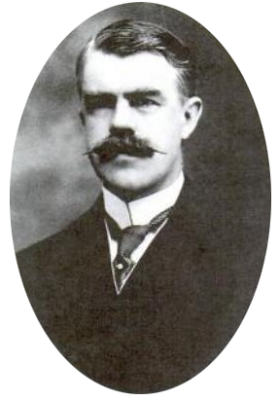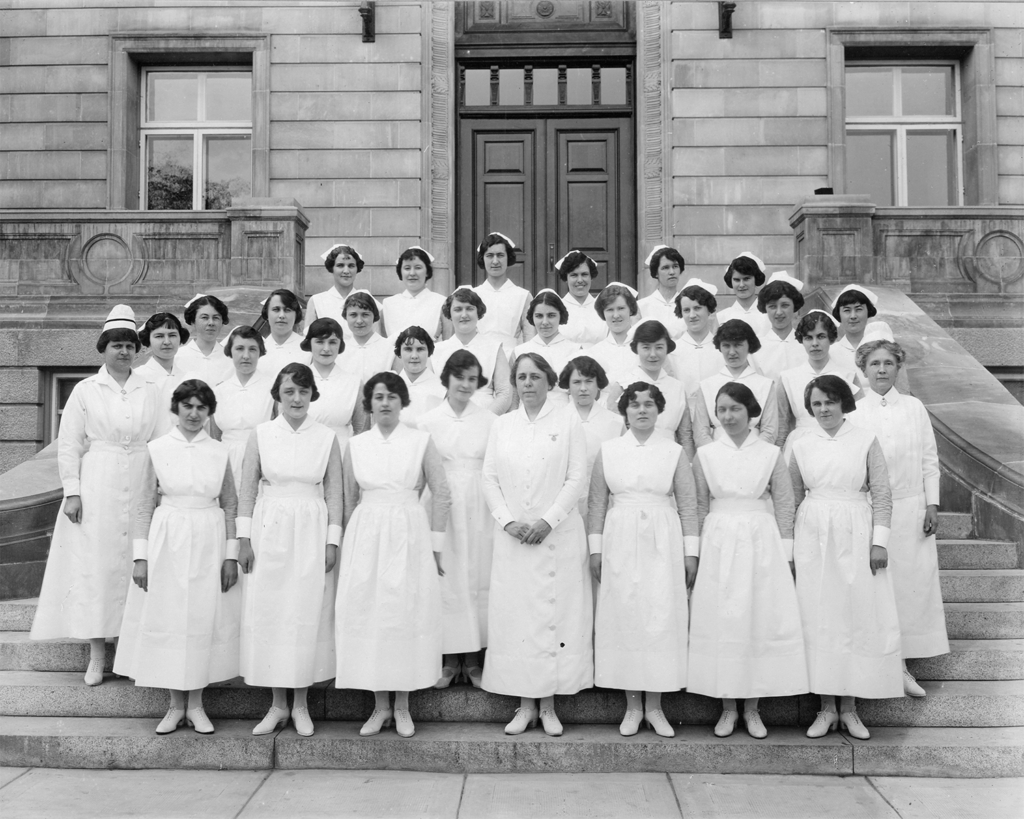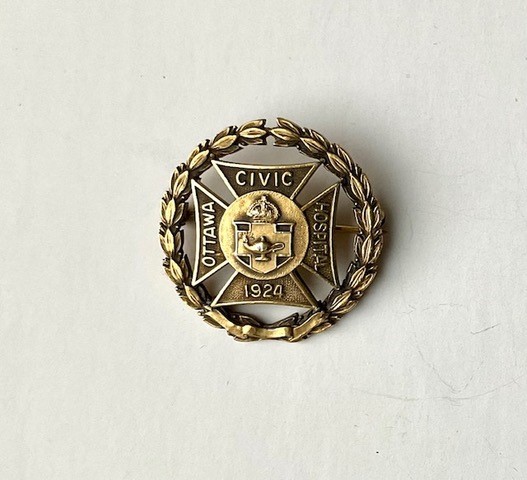
100 MOMENTS
On November 27, 1924, the Civic Hospital opened its doors to great fanfare. The world had just emerged from a pandemic and the community rallied together to make this new hospital a reality.


Though he was roundly ridiculed at the time, Mayor Harold Fisher pushed hard for the construction of the Civic and for a thoroughly progressive vision of medicine.
That defining moment in history went on to improve the lives of every citizen of Ottawa and helped lay the foundation for a century of healthcare advances in Canada.
100 MOMENTS
Celebrating 100 moments
 1953
195340/100 – Civic nurses at the Tulip Festival
Did you know that world-renowned photographer, Malak Karsh, was the one to first suggest creating the Tulip Festival, which has now been running since 1953?
The festival’s main site is just down the street from the Civic Campus, and in this photo, taken by none other than Malak Karsh, you can see Civic nurses strolling past the tulips.

Photo credit: Library and Archives Canada/Department of Employment and Immigration fonds/e010982231 These flowers celebrate the memorable role of the Canadian troops in the liberation of the Netherlands and commemorates the birth of Dutch Princess Margriet in Ottawa during the Second World War. If you missed it, check out Moment #37 which contains a special video message from her Highness!
 2011
201139/100 – Awake Brain Surgery
On March 7, 2011, The Ottawa Hospital’s Civic Campus succeeded in saving the life of 28-year-old Kimberly Mountain after the discovery of a cancerous tumour in her brain.
Her neurosurgeon, Dr. Charles Agbi, would keep her awake during the five-hour operation to remove as much of the tumour as possible.
The procedure, which was far less common back then, allows surgeons to speak with their patient throughout the surgery. As a result, they can better ensure the correct area of the brain is being treated, thereby avoiding impact to the areas that control vision, movement, and/or speech. By keeping Kimberly conscious, the medical team could ask her to move certain body parts and to speak … or even sing!
In fact, during the operation, Kimberly shared with the surgical team her ideal vacation destinations — Disney World and Hawaii — and even sang the Lion King classic Hakuna Matata, which is a Swahili phrase that captures a “problem free” attitude.
Such transformational care, through advances in technology, have also allowed surgeons to perform fluorescence-guided surgery. It uses fluorescence imaging to light up cancerous tissue, allowing surgeons to completely remove tumours in patients.
Kimberly’s surgery was followed by radiation and chemotherapy treatments to kill her remaining cancer. Less than a year after her initial diagnosis, Kimberly was declared cancer free. “Even if the cancer does come back, I am confident that The Ottawa Hospital will be able to save me again, thanks to its constant innovative research and clinical trials that are making treatment better and saving lives,” said Kimberly.
 2018
201838/100 – Corporate smudge standards established
For many patients and families, spiritual practices can help manage the stress of time spent in hospital. During smudging ceremonies, participants burn traditional, medicinal plants and waft the smoke over parts of the body as a spiritually cleansing ritual. It is a part of some, but not all, Indigenous cultures in Canada, and is practiced differently by different communities. It may be part of a patient’s everyday spiritual practices. Patients may also smudge when someone is born, when someone dies, or during a crisis.
In recognition of the importance of spiritual practices for healing, in 2018, The Ottawa Hospital implemented a program to accommodate smudging ceremonies for Indigenous patients and families. Although not a traditional ceremony of the Inuit people, some have adopted the practice and may also request a smudging ceremony.
Patients can request a smudging ceremony at any point, and the hospital provides designated indoor areas, patient rooms (in special circumstances), or outdoor spaces for the ceremony. The hospital can provide medicines for smudging — sage, sweetgrass, cedar, and tobacco — and liquid smudge when smoke cannot be used. Spiritual Care staff and a patient’s care team coordinate smudging requests and ensure all safety protocols are followed to prevent smoke and scent from impacting others.
 1943
194337/100 – Princess Margriet
If you’ve ever wondered why Ottawa has so many tulips, the answer involves a World War, a Royal family, and the chief of obstetrics at what was then the Ottawa Civic Hospital.
Watch this special video message from her Royal Highness, Princess Margriet of the Netherlands, about why the Civic holds a special place in her heart.
 1946
194636/100 – Baby Season at the Civic

DID YOU KNOW? According to Fisher’s Folly: a history of the Ottawa Civic Hospital, 1946 was baby season at the Ottawa Civic Hospital after an infection caused a month-long shut down at the Salvation Army Maternity Hospital. The Civic’s Department of Obstetrics came to the rescue, taking in nearly 1,000 expectant moms and babies. One particular day in June saw 22 babies delivered, prompting this comment from the Chair of the Board of Trustees at the time, E. Norman Smith: “There was such a flood of babies that we didn’t have enough bassinets and we had to use butcher baskets…procured from Canada Packers Limited.”

Photo credit: City of Ottawa Archives MG038-20/CA002462 CA002462  1925
192534/100 – First graduating class of nurses

Thirty-two young women, most of them pictured here from 1925, are the first graduates of the Ottawa Civic Hospital School of Nursing. Only single women “in good health with a robust constitution” were admitted to the red-brick nurses’ residence at 737 Parkdale Avenue, until 1969 when the rules changed, allowing married women into the program. According to archival information, life at the school was demanding and highly regimented. “Smoking, alcohol, and bobbed hair were forbidden.”

Photo credit: Jean Teron Ottawa philanthropist and community-builder Jean Teron proudly wears her mother’s 1924 nursing pin, given to 20-year-old Ida Catherine McDowell when she graduated from the program nearly a century ago. Jean’s sister Katherine also graduated from the Civic Hospital School of Nursing.
“My mother’s hand scratching in her biography says that she was so happy at the Civic to receive a mark of 100 on her medical nursing exam,” says Jean. “My mother says she did really well as an A1 nurse, whatever that is, despite the long hours and very little pay.” Jean says her mother and best friend Jean Forbes were the first Civic graduates to go on to higher education, studying Public Health Nursing at McGill.
By the time the School of Nursing closed in 1973, more than 4,000 graduates had made the symbolic walk down the front steps of the Civic Hospital, marking the start of their nursing career.

